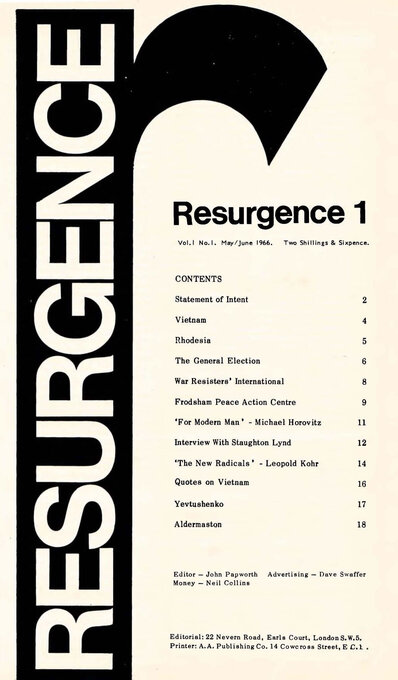Opinions
Articles which express a personal view or analysis of some aspect of our history.
Issues around energy and peace between nations (or even the existence of nation states) have always been an important part of the Eco-Green movement.

 Both Nuclear (power and weapons) and Peace concerns were essential elements of the precursors to the founding of the political green movement. For example the very first issue of Resurgence in May 1966 carried feature articles on Vietnam, Frodsham Peace Action Centre, War Resisters International, and Aldermaston. Satish Kumar, who took, over as editor in 1970, had made his name as a peace activist in 1962 by walking from India to Moscow, Paris, London and Washington (the then "nuclear" capitals) and speaking with the leaders of those nations on the need for detente and peace between nations.
Both Nuclear (power and weapons) and Peace concerns were essential elements of the precursors to the founding of the political green movement. For example the very first issue of Resurgence in May 1966 carried feature articles on Vietnam, Frodsham Peace Action Centre, War Resisters International, and Aldermaston. Satish Kumar, who took, over as editor in 1970, had made his name as a peace activist in 1962 by walking from India to Moscow, Paris, London and Washington (the then "nuclear" capitals) and speaking with the leaders of those nations on the need for detente and peace between nations.
The first issue of the Ecologist in July 1970 carried a major article by Peter Bunyard entitled "Is there a Peaceful Atom?" delving into environmental issues around nuclear power. The Ecologist continued to focus on both energy and peace issues for the next three decades.
- Author: Roger CO

Andrew Pearmain has produced an excellent, detailed and well referenced paper on the Green Party election success - in votes, but not seats - in the 1989 European Election. There is a lot of well researched background detail into the workings of the campaign and the aftermath.
In the light of today's growing mass awareness of the threats of ecological destruction, climate change, and social division there is much food for thought for today's activists from this historical account.
 We are delighted to have the paper itself available in the library. You can download it here or click/tap the thumbnail on the right.
We are delighted to have the paper itself available in the library. You can download it here or click/tap the thumbnail on the right.
The full paper runs to 74 pages. A brief synopsis is provided below.
Synopsis
This study takes a fresh look at the politics of the Green Party of England and Wales, using the 1989 European election as a focus. The Party's performance in 1989, with 2.3 million votes and 15 per cent of the vote, was by far the best performance of any green party in a national election up to that point, and remains the GPEW's best ever. This study examines how that was achieved, with fresh archival research and a thorough survey of the surprisingly meagre literature on the subject.
From there, the author examines
• Where green politics came from, with a comparison between the British situation and other European countries, especially Germany, where a more receptive political system and culture has enabled Die Grunen to establish themselves in the political mainstream.
• Where green politics went after 1989, and how the opportunities presented by the European election were minimised by other political parties but also squandered by the Green Party itself.
• Particular themes and issues within that trajectory, such as the phenomenon of protest voting and 'flash parties', the contours of a politics 'beyond left and right', the relationship between 'movement' and 'party' politics, and the tension between immediate political objectives and grander historical themes (in this case, the global threat of environmental degradation and climate change).
The author concludes with a novel interpretation of the significance of 1989, that it represents a largely inadvertent coincidence of the leftward trajectory of green politics with the rightward trajectory of British society, which is unlikely to recur. It is therefore incumbent on the Green Party itself to devise and promote a conscious political strategy to win mass support among the voting public.
Andrew Pearmain is a political historian, author of 'The Politics of New Labour' (2011) and a forthcoming biography of the Italian Marxist philosopher Antonio Gramsci, and a founder member of the Greenhouse thinktank.
 Click here to download the full paper.
Click here to download the full paper.
- Author: Andrew Pearmain (ed RCO)
This is a guest article by Alex Mitcalfe Wilson copied from the Pantograph-Punch website - a New Zealand based arts and cultural commentary website. In the article the author reflects on the formation of the NZ Values Party and the cultural influences from the UK and also Limits to Growth. Whilst there is no explicit reference to Blueprint for Survival the use of "Blueprint" in the manifesto's title is a bit of a clue...
A further connection is that Teddy Goldsmith's wife Kathy Goldsmith was a New Zealander and frequent visitor. Teddy sometimes accompanied her. Kathy was involved with Values and Teddy regarded it as part of the wave of parties that sprang up around the world in response to Blueprint for Survival. The dates also fit: Blueprint for Survival published, and Movement for Survival launched, January ’72. Blueprint for New Zealand published, and Values launched, May 1972.
- Author: Alex Mitcalfe Wilson
Green Party Origins
In the beginning the party referred to itself as a political ‘movement’ rather than a ‘party’, and its identity was shaped by the merging of two organisations.
The first of these was PEOPLE, assembled in late 1972 and officially launched in February 1973. Founding members Lesley and Tony Whittaker, Michael Benfield and Freda Sanders, known as the Gang of Four, took their inspiration from a report entitled The Limits to Growth, (1972) commissioned by the Club of Rome (a thinktank of scientists, economists, industry and politicians). This document explored various growth scenarios which mostly ended in economic and societal collapse during the 21st century. (Interestingly a 2008 study into the report by the Commonwealth Scientific and Industrial Research Organisation, incorporating actual data of changes to the world since 1972, came to the same conclusions).
- Author: David Taylor
Page 1 of 2
